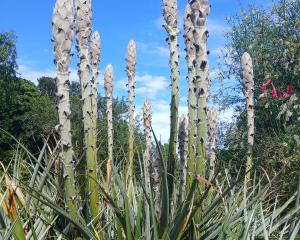Marrying superb views with native trees, a Waitati garden delights Gillian Vine.
"I'm very much a believer in having the mystery unfold," Malcolm Gould says, which is why he likes to meet people at the gate and guide them through the garden at Broadwater.
"If you drive down, you're too busy watching where you're going to appreciate it."
As I had driven in, Malcolm and his partner, Euan Thomson, took me back to start again and appreciate the unfolding mystery.
They bought their land overlooking Waitati's Heron Bay in the early 1980s, then went to Europe for two years, gathering inspiration - and a beautiful Italian dinnerset - as they travelled around in a campervan.
"But I don't believe in copying anything," says Malcolm, a retired interior designer.
The 5200sqm area was "not quite a blank canvas", with some natives, a "landmark oak, apple trees, and a mysterious ring of silver birches on the 'bow' of the promontory", he says.
"Without qualm, we removed a mighty pine, a wattle and seedling Douglas firs," he adds, recalling huge bonfires of debris.
The house came first but it had to reflect the pair's commitment to doing "the very best we could for the land".
They agree that architect Ted McCoy's design met their demands, which included views from every room, walls on which creepers could be grown and terraces like outside rooms.
The house was completed in 1983 and work on the garden began, working out from the house to the far corners.
"We never had a plan. It really was instinct," Euan says.
"It's very poor soil here, no topsoil at all. It would be lovely to have some decent soil ... but there's always something for your soil."
Native plants were a given, and they planted flax and kowhai; encouraged and limbed up the struggling kanuka (Kunzea ericoides) and pittosporums, added dozens more trees, including New Zealand beech, lancewoods (a favourite of Malcolm's), rewarewa (Knightia excelsa), broadleaf, pseudopanax, Hoheria and tree ferns.
The view is filtered by the native trees which have braved prevailing winds for decades. They get a better deal under Malcolm and Euan's stewardship, as they have cleared gorse, broom and blackberry.
Nature joined in - lancewoods seeded and native clematis draped all in its reach, toetoe and mingi mingi arrived courtesy of the birds but, says Euan, "so did the uninvited hopefuls like viburnum, wattle and hawthorn".
In England, Malcolm had been impressed by the work of gardener Gertrude Jekyll and architect Edwin Lutyens, and how their collaborations tied house and garden together.
Broadwater is not all natives.
Rhododendrons were planted under the oak and Malcolm loves roses.
"When he got involved in roses, he came home every day with a boot-load of roses and I was the one who had to dig the holes," Euan says.
Some things were modified, such as moving the drive and vegetable garden when they sold half the property.
The terrace outside the dining area was enhanced by an oblong pool, built by Euan, who recalls: "We didn't have any money, so it had to be me who did it."
Other things worked just too well. A hedge of broadleaf (Griselinia littoralis) "made a dramatic difference" when planted behind the pool but Euan said it had to go. Each time it was clipped, it had to be left a little wider and it simply became too big but its replacement, Corokia, is a winner not only for its grey-green colour but because the small leaves look better when freshly cut.
Asked if they would do things differently now, they agree that they probably would not put in the azalea bed below the house and would have grown more natives to highlight their varied colour and forms.
Being the temporary caretakers of a small wedge of New Zealand's coastline is both an opportunity and responsibility, they say, and it will be a wrench to leave it, Malcolm adding: "Our greatest wish is that whoever inherits our dream retreat will have the passion and respect for our convictions, the tantalising walks and views and, above all, an appreciation for the distinctive atmosphere and the spirit of place."












